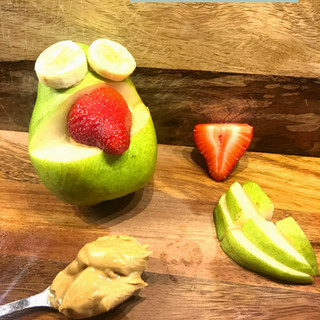Try a fun & easy way to eat fruit: fruit monsters
- Dr. Hansra
- Apr 21, 2022
- 3 min read
Minimizing your children's' intake of processed snacks like potato chips, crackers, and cookies is important in reducing their chances of developing major medical illnesses (1) including the development of #obesity early in childhood (2). Replacing processed snacks with whole fruits and vegetables is a great strategy to boost your children's overall #health (3-5). Kids are notoriously picky eaters and feeding them enough fruits and vegetables can be a challenge but it's not impossible. Visual appearances are very important to children and this trait can be exploited to increase kids' healthy food intake. Essentially if a food looks cool the child will be more likely to try it. Here is a great simple way to increase your child's fruit intake: Fruit monster!

If you give your kids a plate these fruit monsters or a plate of fruit which one do you think they will go for???
Ingredients:
1. Organic apples, pears, or kiwi (makes the head)
2. Organic strawberries (makes the tongue)
3. Sliced almonds (for teeth, hair, and attaching eyeballs) or other seeds work
4. Almond or peanut butter (for sticking things together)
5. Organic blueberries (for the eyeballs)
6. Organic bananas (for the eyeballs)
Directions (takes 2 minutes):
1. Wash all fruit thoroughly
2. Slice mouth shape into fruit as shown (Figure 1) Please watch the video
3. Slice a strawberry in 2 (Figure 2)
4. Slice a banana to make to eyes (Figure 2)
5. Use almond or peanut butter to glue banana and strawberry to fruit (Figure 3) or use an almond slice to attach the banana eye to the head
6. Use almond slices* to attach the blueberry to the banana eyes (Figure 4)
7. Use almond slices* to make the teeth by piercing the fruit (Figure 5)
8. Optional: use the almond slices to make hair, or use leftover fruit to make horns (Figure 6)
* Do not give to infants or babies or small children at risk of choking hazard since almond slices are small. Caution with food products and nut allergies.
What's the bottom line?
Fruits are a great source of fiber, healthy nutrients, and phytochemicals which work to support a wide range of health benefits (4-10). Replacing processed snacks with whole fruits and vegetables is a great strategy to boost your children's overall #health (3-5). Why not just drink fruit juice? One large recent study linked fruit juice consumption with increased risk of early death (11). The authors in this study cite fruit juices as having high sugar contents which is linked to increased obesity and heart disease as a partial explanation for this finding (11). We recognize that most kids are picky eaters but if you make the snack visually appealing and fun then children will be more inclined to try it. Fruit monsters are a simply and easy way to increase your little picky eaters whole fruit intake.
"Replacing processed snacks with whole fruits and vegetables is a great strategy to boost your children's overall #health." - Dr. Damien Hansra MD

Stay tuned on more ways to sneak in fruits and vegetables into your kids foods to boost their health! https://smartandeasyhealth.com
References:
1. Marti A. Ultra-Processed Foods Are Not "Real Food" but Really Affect Your Health. Nutrients. 2019;11(8):1902.
2. Costa CS, Del-Ponte B, Assuncao MCF, Santos IS. Consumption of ultra-processed foods and body fat during childhood and adolescence: a systematic review. Public Health Nutr. 2018 Jan; 21 (1): 148-159.
3. Pem D, Jeewon R. Fruit and Vegetable Intake: Benefits and Progress of Nutrition Education Interventions- Narrative Review Article. Iran J Public Health. 2015;44(10):1309–1321.
4. Dreher ML. Whole Fruits and Fruit Fiber Emerging Health Effects. Nutrients. 2018;10(12):1833. Published 2018 Nov 28.
5. U.S. Department of Health and Human Services and U.S. Department of Agriculture Dietary Guidelines for Americans 2015–2020. [(accessed on March 5, 2020]; Available online: http://health.gov/dietaryguidelines/ 2015/guidelines/.
6. Slavin J.C., Lloyd B. Health benefits of fruits and vegetables. Adv. Nutr. 2012;3:506–512.
7. Marlett J.A., Cheung T.-F. Database and quick methods of assessing typical dietary fiber intakes for 228 commonly consumed foods. J. Am. Diet. Assoc. 1997;97:1139–1148.
8. USDA . National Nutrient Database for Standard Reference. USDA; Washington, DC, USA: 2018.
9. Baker B.A. Reassessment of some fruit and vegetable pectin levels. J. Food. Sci. 1997;62:225–229.
10. Padayachee A., Day L., Howell K., Gidley M.J. Complexity and health functionality of plant cell wall fibers from fruits and vegetables. Crit. Rev. Food Sci. Nutr. 2017;57:59–81.
11. Collin LJ, Judd S, Safford M, Vaccarino V, Welsh JA. Association of Sugary Beverage Consumption With Mortality Risk in US Adults: A Secondary Analysis of Data From the REGARDS Study. JAMA Netw Open. 2019;2(5):e193121. Published 2019 May 3.
Disclaimer:
As a service to our readers, Smart and Easy Health. com provides access to our library of archived content. Please note the date of last review on all articles. No content on this site, regardless of date, should ever be used as a substitute for direct medical advice from your doctor or other qualified clinician. Do not ingest any food products you are allergic to.



















Comments